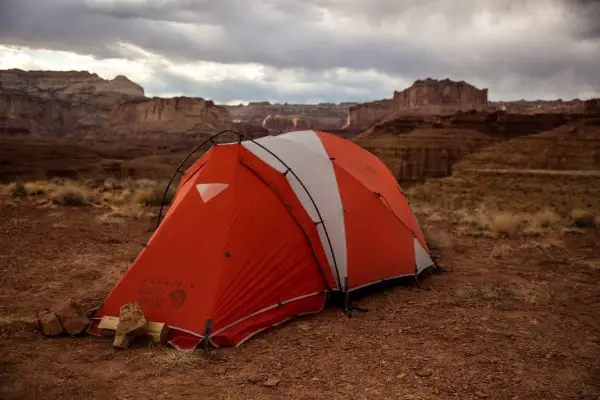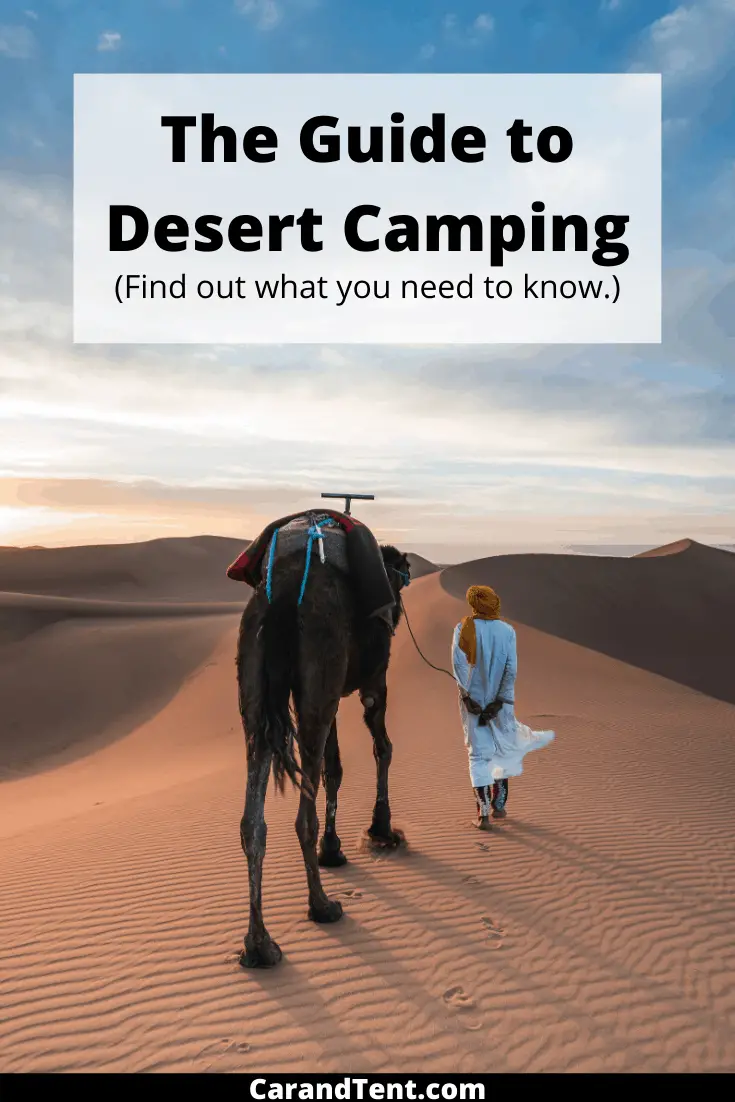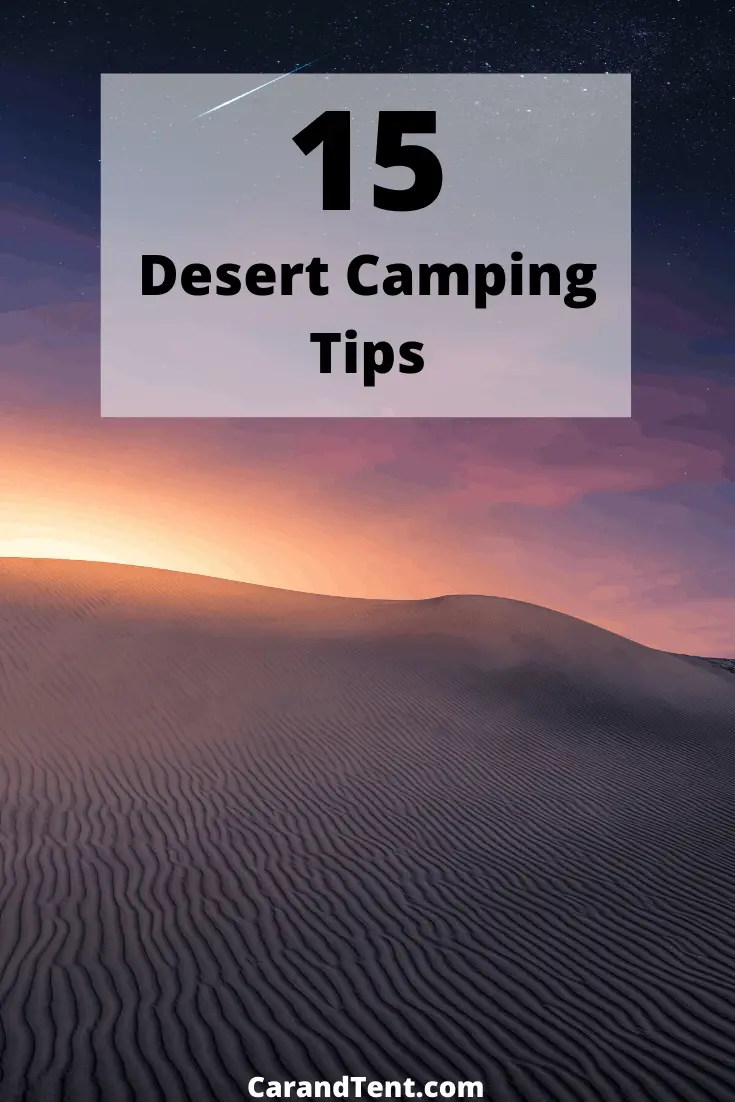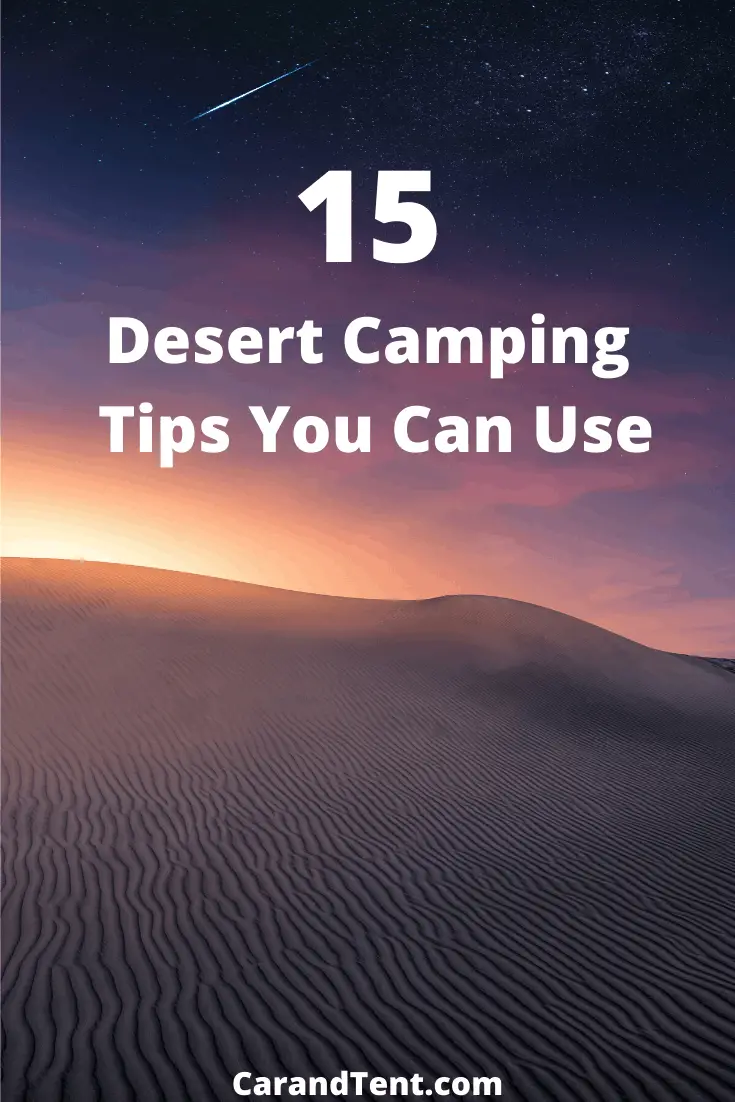
Being from the northeastern part of the country I never even considered what it would be like to camp in the desert until a few years ago. I’d wanted to visit Joshua Tree and a few other places but never really considered what challenges might await me.
After doing a lot of research, I realized that camping in the desert is hard work. There are many unique challenges that people have to think about before venturing out into the desert and not doing so could prove deadly.
For this reason, I created this guide on how to camp in the desert. Here is what you’ll need to do.
- Time your trip, so you don’t die.
- Pack enough water.
- Keep your food safe from desert animals.
- Pack clothing for both cold and hot weather.
- Bring snake and cactus proof footwear.
- Beware of things that can bite or sting you.
- Be careful where you set up camp.
- Bring overhead coverage.
- Pack for sand storms.
- Pack a first aid kit specifically meant for the desert.
- Be ready for wet weather.
- Bring a sleeping pad.
- Pack protection from the sun.
- Bring the right vehicle.
- Know what to do after your trip is over.
Table of Contents
1. Time Your Trip
Did you know deserts have monsoon seasons? I didn’t either. Imagine heading out into the desert only to get blasted by drenching rains. This doesn’t seem fun to me and from what people have told me, it isn’t. In fact, it can even be dangerous as all sorts of life-threatening events can occur during a monsoon in the desert. Floods, landslides, and sand storms are just a few of the dangers you can face during monsoon season in the desert.
The fear of death isn’t the only issue to worry about when timing a camping trip into the desert. You also have to consider your comfort. For example, the middle of the summer is sweltering in the hot and dry desert. If you’re not used to 100 plus temperatures you might just not have any fun. For this reason, some people prefer to do their desert camping in the spring or fall. Know what your limits are and plan your trip accordingly.
2. Pack Enough Water
Forgot to bring enough water into the Adirondack Mountains? No big deal, just pull out your water filter and fill up at the next stream. Forgot to bring enough water with you into the desert? Better hope you ignored my initial advice and went camping during monsoon season. If not, you’ll probably die out there.
This might seem obvious but many people have died or become severely dehydrated because they neglected to pack enough water with them when camping in the desert. The heat is dry out in the desert and people need to drink more water than they do in the forest. This is true even if the temperatures are the same.
Go hiking in the desert for an hour and you could lose up to half a gallon of water. For this reason, I’d plan on bringing three times as much water as you normally would. Do this as a baseline and then add a little more for emergencies. This means that if you normally pack a gallon of water a day, bring three gallons per day instead.
Also, don’t assume any springs will still have water when you get there. Springs can dry up at a moment’s notice and relying on them can be dangerous. If the spring happens to have water in it when you arrive, just enjoy the extra water you now have.
3. Keep Your Food Safe from Animals
Not everyone is aware of this but the desert has bears. It has bears, mountain lions, coyotes, and vermin and they all want to eat your food.
Different areas will have different safety rules but it is best to be overcautious rather than not cautious enough. Assume the area has bears and pack a bear canister for your food. This is important in the desert as you won’t be able to hang your food from a tree like you would be able to do in the woods.
4. Pack the Right Clothing
Everyone knows the desert gets hot during the day but did you know that it can get really cold at night? The stark contrast between hot and cold weather can be hard on the human body and you won’t ever have a chance to get used to either temperature change.
For this reason, it is important that you bring both hot and cold weather gear. You’ll need breathable, moisture-wicking clothing for the day and winter clothing for the cold nights. This isn’t as simple as packing an extra sweatshirt or two. You may need gloves and a wool hat to help you get through the cold nights and you’ll certainly need a warm sleeping bag.
5. Bring Snake and Cactus Proof Footwear
Accidentally step on a rattlesnake and you could end up dead. Desert canyons can be filled with camouflaged snakes and you might not always see them until it is too late. This is especially true if you’re trying to take in the beauty of the desert.
Because of this, you might want to wear kevlar boots or some other bite-proof footwear. Doing so could be the difference between you dying in the desert versus having a magical camping and hiking experience.
On a more benign note, cactuses can hurt your feet. It is doubtful that you’ll die from accidentally stepping on some cactuses but you won’t have any fun if your feet are in pain throughout the duration of your trip. Wear thick footwear and you’ll bring back memories of the breathtakingly beautiful night sky instead of memories of how bad your feet hurt during your trip.

6. Beware of Things That Can Bite and Sting You
We already talked about snakes, bears, mountain lions, and coyotes but there are other things that can bite and sting you as well. Fire ants, wasps, spiders, and scorpions can all cause bites that lead to deadly reactions. Even if it doesn’t end up being that severe it can still be painful.
Before sitting down to rest, check the area to make sure you aren’t sitting down on an anthill, a wasp nest, or an angry scorpion. Also, be sure to shake out your gear each day so that you don’t inadvertently put your hands on a poisonous bug or insect.
7. Be Careful Where You Setup Camp
Did you know that many people have drowned in the desert? It sounds impossible but the desert can flood from time to time. Even if it isn’t raining in the area you’re in, water can flow through canyons and flood plains at a moment’s notice and you can be swept away forever.
To avoid situations like this, never set up camp in a canyon or any other area that looks like it may have held water at one time. These areas have probably been flooded before and they’ll probably end up flooding again.
Also, remember that the desert floor isn’t always a great place to set up a tent. Stakes may not go into the ground and you probably won’t have any trees to tie your tent to. In this case, you may want to bring a rope and tie-downs that you can attach to rocks to keep your tent in place. When the wind comes howling through your campsite, you’ll be glad you did.
8. Bring Overhead Coverage
Leaving your tent set up all day long is the best way to ensure that your tent will be too hot to go into until nightfall. There is a way you can avoid this though. One way is to bring a tarp that is large enough to cover your entire tent.
Another way is to take your tent down each morning. Take your tent down and set up a small tarp or umbrella for you to sit under and you might end up in an area that is 20 degrees warmer than outside of the overhead cover. This is the one advantage of not having any humidity. Sitting in the shade is dramatically cooler than being out in the sun.
9. Pack for Sand Storms
Sand storms can force sand into your mouth, your nose, your ears, and even into your eyes. These storms can come on quickly and you might not have a whole lot of time to prepare for them.
To prepare yourself for sand storms, bring goggles, and something to cover your nose and mouth with. You may even want to cover your ears as well. I mean, who wants to spend their camping trip cleaning sand out of their ears?
Some people will bring bandanas so they can quickly pull them up over their faces while others will bring dust masks. Bandanas are cheaper and more comfortable but a good dust mask mey be more effective.
10. Pack a Desert First Aid Kit
You’ll want to pack the usual items like bandaids, gauze, antibiotic cream, and aspirin. On top of this, you may also want to pack a few items that you might not normally pack. Items like anti-burn cream can help with bad bouts of sunburn and antihistamines can help if you end up getting stung by a poisonous bug or insect.
Additionally, you may want to print out first aid steps for issues that might spring up during your trip. For example, the desert usually has rattlesnakes. Will you remember what to do after a rattlesnake has bitten you or your camping buddy? If not, print out the rattlesnake first aid guide and put it in your first aid kit.
Speaking of knowing what to do, it is always a good idea to learn how to use everything in your first aid kit before you head out. A first-aid item that you don’t know how to use is basically useless in an emergency. Practice using bandages and making tourniquets ahead of time and you’ll stand a much higher chance of survival in an emergency situation.
11. Be Ready for Wet Weather
As we said earlier, just because you’re in the desert it doesn’t mean you won’t get rained on. Pack wet-weather gear and be prepared to spend your trip camping in the rain.
If you’ve decided to cowboy camp, (ie, camp without a tent), at least bring a tarp so that you can keep the rain from falling on you. You should have one to keep the sun off of you anyway so this tarp can serve two purposes for you.
Luckily, you’re in the desert, so most of your gear will dry out shortly after the rain stops. After the rain is over, place your gear in the sun to dry. Just make sure you be cautious of snakes and scorpions when collecting all of your gear back up as both of these critters love to hide in the shade after the sun has come out.
12. Bring a Sleeping Pad
When you’re in the woods you can usually find a nice soft patch of dirt to bed down on. If you can’t, you can always find some pine needles or soft branches to make a bed for yourself. In the desert, you don’t have this luxury.
The desert ground is usually dry and hard. Sleeping on the ground in the desert is closer to sleeping in a cement parking lot than it is to sleep in the woods.
Pack a nice sleeping pad and a sleeping bag and your body will thank you for it in the morning. Also, be careful of inflatable pads and mattresses. Between rocks and cacti, you may end up with a few holes in your inflatable.
13. Pack Protection From the Sun
In addition to overhead coverage, you’ll also want to pack personal protection from the sun. Suntan lotion and lip balm are helpful but it really isn’t a good match against the hot desert sun.
You don’t have to wrap yourself up like Lawrence of Arabia but you do need to make sure your face and body have additional shade. Bring sunglasses, a wide-brimmed hat, and long sleeve shirts and pants to help protect you against the sun.
Make sure the hat has proper ventilation built into it or you may end up getting hot and taking it off. A hat that isn’t worn won’t provide any protection at all.
14. Bring The Right Vehicle
Some desert roads are treacherous and many are unpaved. If you have a rear-wheel drive vehicle and the road calls for a 4×4, don’t risk it. Getting stuck in the desert is dangerous and help might not ever come.
The Oregon Natural Desert Association recommends that you bring:
- A full-size spare tire, a lug wrench, and a 1’x1′ board to place the jack on.
- Extra vehicle fuel.
- Extra engine coolant.
- Extra oil.
- A shovel.
- Tow-straps.
- Jumper cables.
- A fire extinguisher.
Also, keep in mind that gas stations are often few and far between on desert roads. You’ll want to take every opportunity you can to fill up your gas tanks as you never know when you’ll be able to fill up again.
Get stuck in the desert without any gas or cell phone reception and you might have to wait for days before anyone finds you.
15. Know What to Do When the Trip Is Over
Going into the desert is like going on an epic journey. You don’t just come home from it and toss your gear into the garage. You’re probably going to have to change out the air filters on your vehicle and you’re going to have to clean the sand out of all of your gear.
To get sand out of your camping gear, start by vigorously shaking it. After this, set everything up including your tent, and take a soft broom to it all to sweep as much as you can off of it. If you think your gear can handle it, use a vacuum on the low setting to suck any stubborn sand out of crevices in your gear. This is especially useful for getting sand out of backpacks and in between straps.





